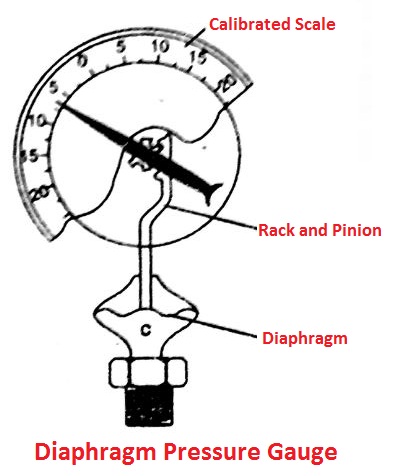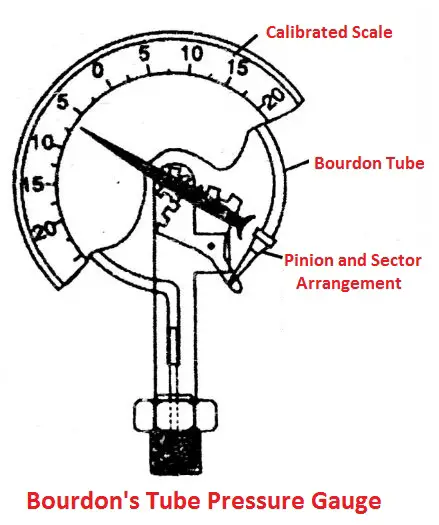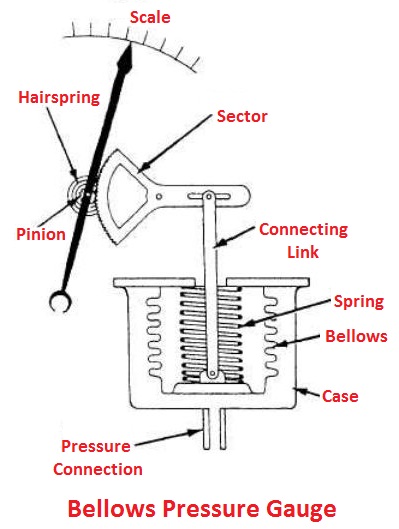In this post, you will learn what is a Pressure gauge and how it is done with Its Working principles, Applications, Advantages, Types of pressure gauges, and more
Mechanical Pressure Gauges
Pressure measurement is the study of the force applied by a fluid to a surface. Pressure is usually calculated in units of force per unit of surface area. The pressure gauges or mechanical gauges are the devices used for measuring the pressure by balancing the column of fluid by spring or dead weight.
Types of Pressure Gauges
Following are the commonly used mechanical pressure gauges:
- Diaphragm pressure gauge
- Bourdon tube pressure gauge
- Bellows pressure gauge
- Dead-weight pressure gauge
1. Diaphragm Pressure Gauge
A mechanical pressure-measuring instrument used to measure pressure above or below the atmospheric pressure. It is usually employed to measure relatively low pressures. A diaphragm pressure gauge, in its simplest form, consists of a corrugated diaphragm as shown in the figure.

The gauge is connected to the fluid which is under pressure causing some deformation of the diaphragm. With the help of a pinion system, elastic deformation of the diaphragm rotates the pointer. This pointer moves over a calibrated scale, which directly gives the pressure.
Read Next:
- Vernier Caliper: Types, Parts, Working Principle, Least Count, and More
- Micrometre Screw Gauge and Types of Micrometers
Advantages of Diaphragm Pressure Gauge
- This is good for low pressure.
- It is inexpensive.
- It has a wide range
- Used to measure gauge, atmospheric and differential.
- it is very reliable.
Disadvantages of Diaphragm pressure gauge
- Impact resistance is not good.
- Difficulty in maintenance.
- Lower measurement pressure.
2. Bourdon’s Tube Pressure Gauge
A mechanical pressure-measuring instrument employing as its sensing element a curved or twisted metal tube flattened in cross-section and closed known as the Bourdon tube.

It is a device for measuring the pressure of gases or liquids. It consists of a semicircular or coiled, flexible metal tube connected to a gauge, which records the degree to which the tube is straightened by the pressure of the gas or liquid inside. Generally, it is used for measuring high pressures.
The instrument is connected to the fluid which is under pressure and flows into the Bourdon’s tube. As a result of the increased pressure, the tube tends to straighten itself. Since the tube is encased in a circular cover, therefore it tends to become circular instead of straight.
With the help of a simple pinion and sector arrangement, the elastic deformation of the Bourdon’s tube rotates the pointer. This pointer moves over a calibrated scale, which directly gives the pressure.
Advantages of Bourdon Tube Pressure Gauge
- Construction is simple and the cost is low.
- It has excellent sensitivities.
- It has high accuracy.
- This gauge is available for various ranges
Disadvantages of Bourdon Tube Pressure Gauge
- Slow response to a change in pressure.
- Prone to shock and vibrations.
- It is subjected to hysteresis.
- Not available for the low-pressure condition.
Application of Bourdon Tube Pressure gauge
- Gas distribution system.
- Used in the hydraulic installation.
- Used in pneumatic installation.
3. Bellows Pressure Gauge
It is a device, the pressure-responsive element is made of a thin metal tube with a deep circumference when the pressure changes as the elastic elements increase or decrease.

A pointer is connected to it which indicates reading on the circular dial. It expands when the pressure increases and when the pressure is low the elastic elements in the pressure gauge contract.
That’s it. Thanks for reading if you have any questions about “Types of Pressure Gauge” ask in the comments. If you found this post helpful then please share it with your friends.
Download PDF of this article:
Read also: